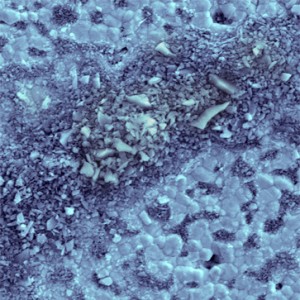Silver and Silica

Silicosis is one of the oldest known and widespread occupational lung diseases. Caused by the inhalation of dust containing crystalline silica (SiO2), it kills thousands of people each year around the world. Silica is one of the most common minerals found in the crust and is released into the air when rocks, concrete, or sand are crushed, broken, or sprayed. Construction workers, miners and those that work with masonry, glass, and ceramics are particularly susceptible to exposure to airborne silica dust. When inhaled, silica dust can lodge itself into the alveoli of lungs, deep enough that coughing and mucus cannot to remove it. The tiny particles cause inflammation and, eventually, the build-up of scar tissue in the lungs. The progress of the disease is gradual; many people with silicosis experience no symptoms initially. However, as the nodules of fibrous scar tissue grow larger, symptoms such as chronic coughing, shortness of breath, chest pain, and fatigue can develop. Silicosis can also create other health complications such as bacterial or fungal infections, emphysema, and even cancer. Though it is widespread, especially in the developing world, silicosis is also preventable by limiting exposure to crystalline silica with protective equipment, and good dust control measures. The American Lung Association recommends steps such as using water sprays to lower the amount of airborne dust, using a properly fitted respirator, and practicing good workplace hygiene to minimize contact with crystalline silica dust. The Occupational Safety and Health Administration (OSHA), currently sets the permissible exposure limit for respirable silica dust at 100 ?g/m3 as an eight-hour time-weighted average although it is also proposing to lower that limit to 50 ?g/m3. Environmental monitoring of the work site through air sampling and laboratory analysis is an important step in determining if protective equipment and dust control measure are adequately protecting workers from crystalline silica dust. The primary analytical method for determining the crystalline silica content of a sample is through x-ray diffraction (XRD) and the standard procedures for conducting this type of analysis on respirable silica dust are NIOSH 7500 and NIOSH 7501. Both of these methods involve the use of a Sterlitech silver membrane filter as the substrate that the sample is mounted prior to x-ray exposure. Silver membranes make excellent substrates for XRD analysis thanks to their smooth, reflective surface, low background noise, and distinct diffraction peaks. The widespread adoption of protective equipment, dust control, and environmental monitoring have helped sharply reduce the incidence of silicosis in the United States. However, the abundance of silica means that the risk of developing silicosis remains ever present for people who work in construction, mines, quarries, and in the manufacture of powders, glass, and ceramics. Further information: "Preventing Silicosis and Deaths in Construction Workers." Centers for Disease Control and Prevention. June 6, 2014. "Hazard Prevention and Control in the Work Environment: Airborne Dust (WHO, 1999)." WHO. "Silicosis." Occupational Safety and Health Administration. "Preventing Silicosis." American Lung Association.
- Most Viewed Blog Articles (5)
- Company News (285)
- Emerging Technologies (64)
- Microbiology and Life Science News (93)
- Water and Fluid Separation News (97)
- Filtration Resources (93)
- Product News (19)


![Join Sterlitech at BIO 2024 [Booth #5558]: Exploring the Future of Biotechnology](https://www.sterlitech.com/media/blog/cache/300x200/magefan_blog/b4.jpeg)



